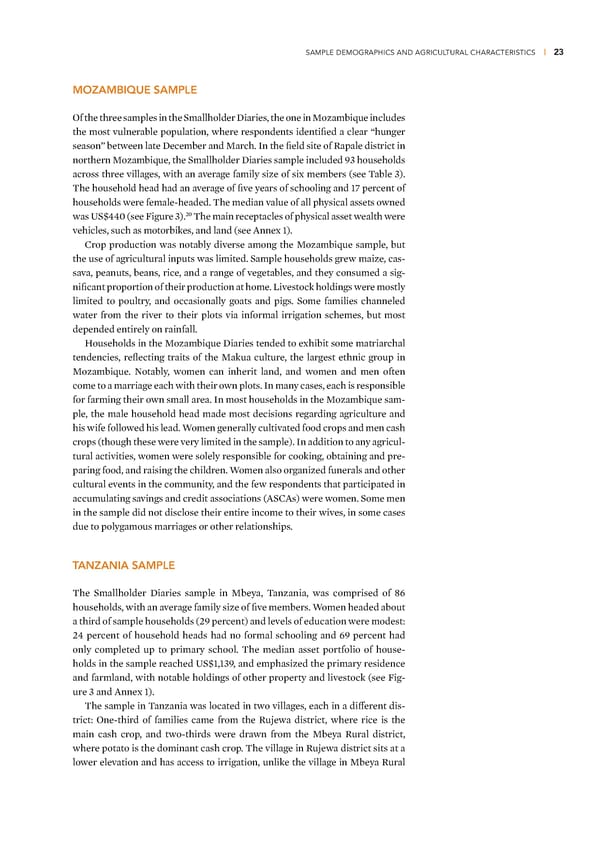SAMPLE DEMOGRAPHICS AND AGRICULTURAL CHARACTERISTICS | 23 MOZAMBIQUE SAMPLE ¦f the three samples in the Smallholder ‰iaries, the one in –o—ambiue includes the most vulnerable population, where respondents identified a clear “hunger season” between late ‰ecember and –arch €n the field site of ªapale district in northern –o—ambiue, the Smallholder ‰iaries sample included žŸ households across three villages, with an average family si—e of six members (see Œable Ÿ) Œhe household head had an average of five years of schooling and …• percent of households were female-headed Œhe median value of all physical assets owned ‘’ was ©S±““’ (see igure Ÿ) Œhe main receptacles of physical asset wealth were vehicles, such as motorbies, and land (see ˆnnex …) †rop production was notably diverse among the –o—ambiue sample, but the use of agricultural inputs was limited Sample households grew mai—e, cas- sava, peanuts, beans, rice, and a range of vegetables, and they consumed a sig- nificant proportion of their production at home ƒivestoc holdings were mostly limited to poultry, and occasionally goats and pigs Some families channeled water from the river to their plots via informal irrigation schemes, but most depended entirely on rainfall Households in the –o—ambiue ‰iaries tended to exhibit some matriarchal tendencies, reflecting traits of the –aua culture, the largest ethnic group in –o—ambiue ˜otably, women can inherit land, and women and men often come to a marriage each with their own plots €n many cases, each is responsible for farming their own small area €n most households in the –o—ambiue sam- ple, the male household head made most decisions regarding agriculture and his wife followed his lead ™omen generally cultivated food crops and men cash crops (though these were very limited in the sample) €n addition to any agricul- tural activities, women were solely responsible for cooing, obtaining and pre- paring food, and raising the children ™omen also organi—ed funerals and other cultural events in the community, and the few respondents that participated in accumulating savings and credit associations (ˆS†ˆs) were women Some men in the sample did not disclose their entire income to their wives, in some cases due to polygamous marriages or other relationships TANZANIA SAMPLE Œhe Smallholder ‰iaries sample in –beya, Œan—ania, was comprised of ¡¢ households, with an average family si—e of five members ™omen headed about a third of sample households (‘ž percent) and levels of education were modest ‘“ percent of household heads had no formal schooling and ¢ž percent had only completed up to primary school Œhe median asset portfolio of house- holds in the sample reached ©S±…,…Ÿž, and emphasi—ed the primary residence and farmland, with notable holdings of other property and livestoc (see ig- ure Ÿ and ˆnnex …) Œhe sample in Œan—ania was located in two villages, each in a different dis- trict ¦ne-third of families came from the ªu„ewa district, where rice is the main cash crop, and two-thirds were drawn from the –beya ªural district, where potato is the dominant cash crop Œhe village in ªu„ewa district sits at a lower elevation and has access to irrigation, unlie the village in –beya ªural
 Financial Diaries with Smallholder Families Page 34 Page 36
Financial Diaries with Smallholder Families Page 34 Page 36